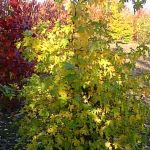| Common Name: |
Oriental Sweet Gum |
| Other Names: |
Storax |
| Botanical Name: |
Liquidambar orientalis |
| Genus: |
Liquidambar |
| Family: |
Hamamelidaceae |
| Native Location: |
SW Asia |
| Cultivation: |
Deep, rich, moist, neutral to slightly acid soil in sun or partial shade. |
| Propagation: |
By seed sown in autumn; by greenwood cuttings in summer. |
| Harvest: |
Balsam is collected as a natural exudate, or from cuts in the bark, and made into syrups and tinctures. It is also extracted from the bark, after beating the trees to increase flow. |
| Height: |
30m (100ft) in the wild, 6m (20ft) in cultivation. |
| Width: |
4-20m (12-70ft) |
| Hardiness: |
Z7-9 |
| Parts Used: |
Balsam (su he xiang) |
| Properties: |
An aromatic, stimulant herb that is antiseptic and anti-inflammatory, has expectorant effects, and promotes healing. |
| Medicinal Uses: |
Internally for strokes, infantile convulsions, coma, heart disease, and pruritis. Externally, mixed with olive oil, for scabies (Leaves, fruits, and roots are also used in similar ways in folk medicine.) |
| Bibliography: |
Encyclopedia of Herbs by Deni Brown Copyright © 1995, 2001 Dorling Kindersley Limited Pg 264 |

